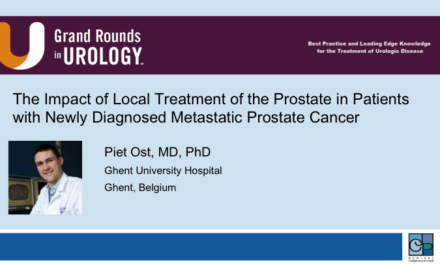Dr. Robert Abouassaly, MD, presented “An Overview of MRI Guided Biopsies for Prostate Cancer” at the 26th Annual Perspectives in Urology: Point-Counterpoint, November 12, 2017 in Scottsdale, AZ
How to cite: Abouassaly, Robert “An Overview of MRI Guided Biopsies for Prostate Cancer” November 12, 2017. Accessed Nov 2024. https://dev.grandroundsinurology.com/overview-mri-guided-biopsies-prostate-cancer/
Summary:
Robert Abouassaly, MD, discusses the different components that are required in order to perform an MRI-guided biopsy for localized prostate cancer
An Overview of MRI Guided Biopsies for Prostate Cancer
Transcript:
Thank you very much. So I have a couple of quick audience response questions. So all of the following statements about prostate cancer on MRI are true except: A. Appears dark on T2; B. Appears dark on DWI; C. Has low ADC; and D. Underestimates tumor volume.
Okay. Very good. We’ll talk about that and we’ll go over that one more time at the end.
So all of the following statements about MRI-guided biopsy are true, except there is no evidence to suggesting that MRI-guided biopsy is cost effective. Combination of MRI-guided biopsy and standard biopsy most accurately characterizes prostate cancer. MRI-guided biopsy most often misses tumors in the lateral peripheral zone and apex. Standard biopsy often misses tumors in the transitional zone and anteriorly.
Okay. Yeah, we’ll go over that. All right. So I thought that probably the best way to go over MRI-guided biopsy is to talk about the different components that are required in order to perform an MRI-guided biopsy.
So first, we’ll talk about the ability of the MRI to identify the cancer accurately. We’ll talk about transferring that information from the MRI to the time of the biopsy. We’ll talk about targeting of lesions and the issues that can up when trying to target them at the time of biopsy.
Ideally, these biopsy would increase the detection of clinically significant prostate cancer and decrease the detection of incidental low-risk prostate cancer. And also, accurately identify state and grade in order to provide information on treatment planning. And ideally, of course, they would be cost effective as well.
Okay. So what is the appearance of prostate cancer on MRI? Well, as you probably know, prostate cancer tends to be dark on T2-weighted imaging. It actually appears light on diffusion-weighted imaging, but the ADC value is low, and we’ll briefly talk about what that means. And it has a typical enhancement pattern on dynamic contrast enhancement.
So the way I like to think about it, and it’s a simplistic way and probably not completely accurate, but I like to think about how easy is it for water to diffuse through the tissues of the prostate. So when you have a benign prostate with benign glands or low-risk prostate cancer, cells and glands tends to be spaced out, so water can easily diffuse through the tissues. And so you’d expect a high ADC value, so that appears bright on the ADC images.
Whereas with tightly-packed cells, such as in high-risk prostate cancer, it is hard for water to diffuse through the tissues. And so the ADC value will be lower. And what has been shown is that the grade of the tumor is inversely related to the ADC value.
And this is the PI-RADS classification which I’m sure you’re aware of. But this is version 2, and version 2 is heavily weighted on the diffusion-weighted images, and that is basically what categorizes tumors from 1 to 5. And dynamic contrast enhancement really serves a minor role. It will push PI-RADS 3’s to the 4 category if you have focal early enhancement. But otherwise, it doesn’t play a major role in the version 2 of PI-RADS.
And the only difference between PI-RADS 4 and PI-RADS 5 has to do with the size of the lesions. So lesions greater than 15 millimeters are considered PI-RADS 5.
So what are the clinical characteristics of prostate cancers that are visible on MRI. This study looked at 122 patients with pre-radical prostatectomy MRI’s. And what they found is that tumors that are smaller than .5 to 1 centimeter in diameter are often missed. So everything above the line there is missed tumors.
Those are often missed on MRI. Gleason 6 prostate cancers are often missed on MRI as well. Non-index lesions often not seen and multi-focal tumors also are more likely to be missed. But overall, they found a 68 percent rate of detection of clinically significant tumor foci, and that’s defined as tumors greater than 1 centimeter, Gleason score is greater or equal to 7, and well as index tumors. And they estimated that the sensitivity for MRI for the detection of Gleason 3+4 was 72 percent and a little lower at 68 percent for Gleason 4+3.
This paper just came out in Journal of Urology and is important because as many of us know MRI tends to underestimate the size of the tumor. This was a 118 tumors seen on MRI and compared to whole-mount prostatectomy specimens. And what they found is that the MRI underestimated tumor diameter by an average of 11 millimeters and tumor volume was three times greater in whole-mount specimens compared to T2.
So this has important implications with respect to treatment planning, particularly if one is considering focal therapy which is, you know, hot these days and a lot of people are talking about it. But we need to be able to accurately identify the margins of the tumor in order to focally treat the prostate cancer. And MRI doesn’t do it accurately enough at the current time.
So how good is MRI at pathologic staging. A systemic review looked at this — 75 studies, close to 10,000 patients. They all had multi-parametric MRI and they looked at its ability to detect extraprostatic extension or seminal vesicle invasion using a radical prostatectomy pathology as a reference standard.
And overall, MRI is not great, so it does not have good sensitivity for extraprostatic extension or seminal vesicle invasion with sensitivities of 57 to 58 percent. But specificity is good, so if they do see it, it is likely there.
That’s if you use MRI in isolation, that information in isolation. But interestingly, if you combine the information from the MRI into known risk models, this study looked at additional information provided by the MRI and when combined with either the CAPRA score or – – tables, and what they found was MRI increased the accuracy of the model in detection of extra-prostatic extension and seminal vesicle invasion substantially increasing the accuracy, but interestingly it did not increase the accuracy of detection of lymph node involvement.
This is the PROMISE study, a large U.K. study that was published this year. They looked at 576 men. These were biopsy naïve men. All men underwent 1.5 Tesla MRI, standard TRUS biopsy as well as a transperineal mapping template biopsy, and they defined clinically significant prostate cancer as those greater or equal to 4.3 or greater than 6 mm in continuous cancer length. Overall detection rate was 71%, with 40% of patients having clinically significant prostate cancers, and they found it impressive sensitivity of MRI of 93% for the detection of clinically significant prostate cancer, with a lower specificity and TRUS biopsy had the opposite finding, so it was not as sensitive, but it was more specific, and they estimated that if you used MRI to triage patients with suspicion for prostate cancer and to decide who should and shouldn’t get a biopsy, you could avoid 27% of biopsies and diagnose 5% or fewer excuse me 5% fewer clinically insignificant prostate cancers and if you use the information from the MRI to direct your biopsy, they estimated that you would be able to detect 18% more clinically significant cancers that way.
Another study from the U.K. also published this year called the PICTURE trial and they looked at MRI for patients who had previous negative biopsies. And they looked at 249 men. All men had 3-Tesla MRIs and transperineal mapping biopsies, so they used a Likert score to—similar to the PIRAD system to give suspicion for prostate cancer on MRI, and if you use the cut-off of greater than 3 they found excellent sensitivity but specificity wasn’t great. If you used a cut-off of greater than 4 then that decreased sensitivity slightly but made it a lot more specific. So what about negative MRI? Patient has a suspicion for prostate cancer, elevated PSA, but the MRI is negative. Does that mean they do not have clinically significant prostate cancer? Well, a number of studies have looked at this, and overall negative MRI or PIRADs 1 or 2 is seen in about 20 to 50% of patients in these studies. However, the cancer detection rate remained significantly high at 15 to 31% and of those 25 to 79% had Gleeson 3+4, so they estimated that the negative predictive value of an MRI is anywhere from 63 to 98% depending on the study you looked at so there is a potential for missed clinically significant prostate cancers if patients undergo MRI-guided biopsy without standard biopsy.
So let’s talk about transferring of the information now from the MRI to the biopsy. So that is registration of the images or MR ultrasound fusion. This study from Ukimura looked at prostate phantoms with MR-visible lesions that were isoechoic on ultrasound and using elastic fusion that takes into account the deformity or deformation of the prostate at the time of ultrasound due to the probe or other factors. They were able to hit the biopsy 100% of the time, and they estimated that the error rate was only 2.92 mm overall, and if you compared rigid fusion, which doesn’t take into account that deformation, the error rate was quite high at 5-mm but with elastic fusion that decreased it to less than 1 mm. That being said these were prostate phantoms, not patients that were in the office moving, and so the actual error rate is probably significantly higher than that in clinical practice.
What about targeting of lesions? So you have the information, the images in front of you. How are you going to guide your biopsy to that lesion? And there are a number of technologies out there. This is just a few of them, the more popular ones. These technologies either track the probe with GPS such as the Uronav or BK systems where you have this device that hovers over the hip of the patient and keeps track of the ultrasound probe and the 3-dimensional space or the Artemis system, which has a robotic arm, which keeps track of the location of the ultrasound probe, or the Koelis system, which takes actually the prostate location in 3D space into account. They all have their pros and cons. There’s significant learning curve with all of these. They are operator dependent, and there’s a little bit of subjectivity as those who have performed these biopsies know so the technology is okay but it needs to improve for it to be a little more automated and reliable.
So how is MR now at the increased detection of clinically significant prostate cancer? So we’ll go over that now. So a systematic review looked at the MR-guided biopsy for the detection of clinically significant prostate cancer, so overall good but variable, 58 to 96% specificity 23 to 87%, but the conclusion of the review and this was published in European Urology is that you know MR-guided biopsy is substantially better than standard practice, and these data from Peter Pinto’s group at the NCI. They looked at 170 patients who underwent radical prostatectomy and looked at the ability of either targeted biopsy with fusion or standard sextant biopsy at the detection of intermediate to high risk prostate cancer, and what they found was that the targeted biopsy did better than standard biopsy so accuracy of 73% versus 59% for the – – biopsy.
And this study looked at it by the detection of the index tumor, so they looked at the accuracy of multi-parametric MRI, MR-guided biopsy, standard biopsy and the combination of MR-guided biopsy and standard biopsy and what they found is that the accuracy was highest if you combine the standard with MR-guided biopsy and that MR-guided biopsy with standard biopsy detected 97% of all clinically significant prostate foci compared to 85% for multi-parametric MRI. So it appears that the combination at least for now was best at characterizing the tumor.
What are the limitations of MRI and MRI-guided biopsy? Well, we know that it depends on the size of the tumor, and this study looked at that and looked at tumors greater than 0.5 mm in volume, and if tumors were that size regardless of whether they were I the peripheral zone or transitional zone, the identification was quite high, 94, 95%, but if tumors were small, less than 0.5 milliliter despite the fact that they were high-grade or high-risk tumors, detection rate fell dramatically so three-quarters of these tumors were missed.
This mapping study looked at if the different approaches were going to miss tumors, where are these tumors often located, and as you would expect, tumors are missed in different locations depending on if you’re performing a standard biopsy or MR-guided biopsy.
So MR-guided biopsies tend to miss tumors at the base and laterally in the peripheral zone as well as the apex whereas standard biopsy misses tumors anteriorly and in the transitional zone.
So finally how accurate is MR-guided biopsy at the identification of tumor stage and grade, so that is important information for treatment planning. This study looked at data from the promise trial, which I mentioned earlier. They created 3D histopathologic models, which were reconstructed from these transperineal mapping biopsies, and they guided, they performed virtual biopsies guiding one needle into the maximum diameter of these cancers, and they estimated that by doing that you would accurately assess Gleeson grade 94% of the time for all lesions and 79% of the time for heterogeneous lesions.
The second study looked at that as well, and if you look at it per tumor foci, MR-guided biopsy tended to be quite good at identifying the primary Gleeson grade, so it was accurate 90% of the time, but not as good at detecting the secondary Gleeson grade and was only accurate in identifying the Gleeson score two-thirds of the time, and the highest Gleeson grade was under estimated 28% of the time.
This study looked at what PSA value would you expect MR-guided biopsy to upgrade or upstage the tumor, and they found that if the patient’s PSA was greater than 4, the MR-guided biopsy significantly upgraded tumors, so that is where it was probably the most useful. In PSAs less than 4, standard biopsy increased the diagnosis of clinically insignificant prostate cancers.
Finally, let’s talk about cost has this been looked at and yes, recently published in European Urology, gain based on the PROMISE trial and they used models and different clinical scenarios to determine what is the most cost-effective approach to a patient who comes to see you with clinical suspicion for prostate cancer, and what they found is multi-parametric MRI performed first before initial biopsy followed by up to 2 MR-targeted transrectal ultrasound-guided biopsies, was the most cost-effective and detected more clinically significant prostate cancers per pound spent with an incremental cost-effectiveness ratio of 7,000 pounds per quality adjusted life year, which by any standard is quite reasonable. However, they did say that their findings were sensitive to the cost of these tests as well as the sensitivity of MRI targeting by the fusion and long-term outcomes of men with cancer.
So in summary, multiparametric MRI performs poorly for pathologic staging with respect to extracapsular extension or seminal vesicle invasion when used in isolation. But if you combine it with risk models it does improve the performance of the risk models. MRI guided biopsy alone under estimates tumor grade in up to one-third of cases, and a small high-risk cancer less than about 0.5 cc in volume can be missed as well. It appears that MR-guided biopsy plus standard biopsy is probably the most accurate way to characterize the tumor, and that is important in terms of improved decision making.
The targeted biopsies are operator dependent. As I mentioned the technology is evolving. There is a significant learning curve. These technologies do carry some cost, although at least one cost-effectiveness analysis showed that it could be cost-effective. But future studies are needed to prove the value of MR-guided biopsy and decision making.
So again questions: So all of the following statements about prostate cancer are true on MRI except, so one of these is false. Yep, that’s right, so they appear dark on diffusion weighted imaging. Finally, all of the following statements about MR guided biopsy are true except?
[music]
Correct, there is no evidence to suggest that MR-guided biopsy is cost-effective, so there is that one study I just presented that showed that it may be cost-effective. Thank you.
ABOUT THE AUTHOR
Dr. Abouassaly is an Associate Professor of Urology at the Cleveland Clinic in Cleveland, Ohio. He received his medical degree from the McGill University Faculty of Medicine in Montreal, Canada, in 2002. Dr. Abouassaly then went on to complete residencies in Surgery and Urology at the Cleveland Clinic, followed by a Fellowship in Urologic Oncology at the University of Toronto Faculty of Medicine.
He specializes in urology and has published widely about such urologic subjects as nephrectomy, prostate biopsy, and laparoscopic and robotic procedures. In addition to the Cleveland Clinic, Dr. Abouassaly is affiliated with University Hospitals Cleveland Medical Center and University Hospitals Richmond Medical Center.





